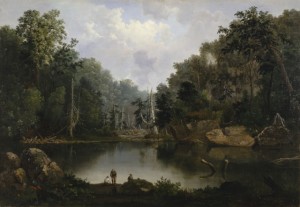- Video: Northern Goshawk Flight in Slow Motion | Audubon Magazine Blog 091613
Alisa Opar: “The northern goshawk is an incredible aerialist. The bird inhabits dense northern forests and maneuvers through impossibly tight spaces in pursuit of prey. A fierce hunter, its quarry includes squirrels, crows, hares, and even other raptors, including merlins and American kestrels (no wonder Attila the Hun’s helmet bore a northern goshawk). See for yourself just how remarkable the accipiter is, in the BBC video below with naturalist Chris Packham.”
- Blue whale earplug reveals lifetime contaminant exposure and hormone profiles | PNAS 091613
Lifetime contaminant and hormonal profiles have been reconstructed for an individual male blue whale (Balaenoptera musculus, Linnaeus 1758) using the earplug as a natural aging matrix that is also capable of archiving and preserving lipophilic compounds. These unprecedented lifetime profiles (i.e., birth to death) were reconstructed with a 6-mo resolution for a wide range of analytes including cortisol (stress hormone), testosterone (developmental hormone), organic contaminants (e.g., pesticides and flame retardants), and mercury. Cortisol lifetime profiles revealed a doubling of cortisol levels over baseline. Testosterone profiles suggest this male blue whale reached sexual maturity at approximately 10 y of age, which corresponds well with and improves on previous estimates. Early periods of the reconstructed contaminant profiles for pesticides (such as dichlorodiphenyltrichloroethanes and chlordanes), polychlorinated biphenyls, and polybrominated diphenyl ethers demonstrate significant maternal transfer occurred at 0–12 mo. The total lifetime organic contaminant burden measured between the earplug (sum of contaminants in laminae layers) and blubber samples from the same organism were similar. Total mercury profiles revealed reduced maternal transfer and two distinct pulse events compared with organic contaminants. The use of a whale earplug to reconstruct lifetime chemical profiles will allow for a more comprehensive examination of stress, development, and contaminant exposure, as well as improve the assessment of contaminant use/emission, environmental noise, ship traffic, and climate change on these important marine sentinels.
- Ear Wax From Whales Keeps Record Of Ocean Contaminants : NPR 091613
How often do whales clean their ears? Well, never. And so, year after year, their ear wax builds up, layer upon layer. According to a study published Monday, these columns of ear wax contain a record of chemical pollution in the oceans. The study used the ear wax extracted from the carcass of a blue whale that washed ashore on a California beach back in 2007. Scientists at the Santa Barbara Museum of Natural History collected the wax from inside the skull of the dead whale and preserved it. The column of wax was almost a foot long.
About the Ghost Turtles
150 years after Robert Duncanson painted this luminist scene on the Little Miami River, I stood in the same spot and saw a soft-shelled turtle sunning on a snag. It slipped silently into the water when it heard me. That’s when I knew past is present and destiny, too. That’s when my vision of the Ghost Turtles began. Read more
Ecology of the Senses
 Returning to Lake Superior year after year like a migrating loon, I’ve learned the other side of a slow, uncertain process that could be called “going blind.” With the lake as my teacher, I know what lies on the other side. I call it letting go of sight. Read more.
Returning to Lake Superior year after year like a migrating loon, I’ve learned the other side of a slow, uncertain process that could be called “going blind.” With the lake as my teacher, I know what lies on the other side. I call it letting go of sight. Read more.Prayer at Big Creek
![Sandhill cranes land on Platte River sandbar roosts west of Rowe Sanctuary’s Iain Nicolson Audubon Center southwest of Gibbon, Nebraska. [Photo by Lori Porter| Kearney Hub]](https://www.ghostturtles.com/wp-content/uploads/2015/03/sandhill_cranes_kearneyhub_032015-300x225.jpg) At the threshold of consciousness, as I slipped back and forth between two worlds, I put my mind in the best place I could imagine, a marsh on Lake Erie called Big Creek. I knew I’d find cranes waiting for me. I cannot say whether I prayed for them, or to them, or with them. The cant of words doesn’t matter. I believe in the still, small voice. I believe what the poet Yehuda Amichai said. Gods come and go. Prayer is eternal. Read more
At the threshold of consciousness, as I slipped back and forth between two worlds, I put my mind in the best place I could imagine, a marsh on Lake Erie called Big Creek. I knew I’d find cranes waiting for me. I cannot say whether I prayed for them, or to them, or with them. The cant of words doesn’t matter. I believe in the still, small voice. I believe what the poet Yehuda Amichai said. Gods come and go. Prayer is eternal. Read moreFreedom to Read
![An endangered Whooping crane takes flight. Yhe large bird has a 7-foot wingspan. It is all white except for black wing tips and face markings. In this photo its long neck stretches forward; its wings sweep upward; and its black legs trail straight behind it. [Source: International Crane Foundation]](https://www.ghostturtles.com/wp-content/uploads/2023/03/Whooping-crane-eastern-ICF-080622-300x157.jpg) Whenever I hear sanctimonious pronouncements about woke, parental rights, and banning books, I think of Whooping cranes. In my family, the gawky, audacious, elusive and endangered birds are synonymous with our values about the First Amendment and the freedom to read. Read more.
Whenever I hear sanctimonious pronouncements about woke, parental rights, and banning books, I think of Whooping cranes. In my family, the gawky, audacious, elusive and endangered birds are synonymous with our values about the First Amendment and the freedom to read. Read more.Sister, Teacher, Pathfinder
 A guidance counselor in high school told my sister Diana, “With your eye problems you will never make it in college. Just forget about it. Get married. Raise a family.” That advice only deepened her determination. She did it all in due time, in her own way –college, marriage, family. She became a guidance counselor herself. She certainly was the most important guide and pathfinder in my life. Read more.
A guidance counselor in high school told my sister Diana, “With your eye problems you will never make it in college. Just forget about it. Get married. Raise a family.” That advice only deepened her determination. She did it all in due time, in her own way –college, marriage, family. She became a guidance counselor herself. She certainly was the most important guide and pathfinder in my life. Read more.Flaneur & Bouquiniste
![Mark Willis peruses a 1745 volume by Voltaire at a bouquiniste book stall on the banks of the Seine in Paris. He wears a brown leather jacket and checkered flat cap. He holds the open book in his hands. Rows of old books are seen on shelves behind him. [2005 photo by Ms. Modigliani]](https://www.ghostturtles.com/wp-content/uploads/2023/03/mw_bouquiniste_05-300x225.jpg) I remember the book I held in my hands that day. I remember the feel of its time-warped, water-stained pages. I remember its murky, moldy river smell, call it the book’s bouquet, suggesting years of storage on the banks of the Seine. Had I bought it then, I could feel and smell it now and know it from a hundred other books in my library. Read more.
I remember the book I held in my hands that day. I remember the feel of its time-warped, water-stained pages. I remember its murky, moldy river smell, call it the book’s bouquet, suggesting years of storage on the banks of the Seine. Had I bought it then, I could feel and smell it now and know it from a hundred other books in my library. Read more.R & K: A Rant
 Marjorie Taylor Green auditioned for R&K’s Authoritarian It Girl at the 2023 State of the Union address. She and her Republican colleagues yelled like Tarzan swinging through the trees as they jeered and booed the President’s speech. Read Rants & Kisses.
Marjorie Taylor Green auditioned for R&K’s Authoritarian It Girl at the 2023 State of the Union address. She and her Republican colleagues yelled like Tarzan swinging through the trees as they jeered and booed the President’s speech. Read Rants & Kisses.R & K: A Kiss
 Songs by Burt Bacharach and Hal David. Singers like Dione Warwick and Dusty Springfield. What Do You Get When You Fall in Love? The Look of Love. I Say a Little Prayer. I sit in the car’s back seat and listen. I’m glad it’s dark. I’d be embarrassed if anyone could see the dreamy look on my face. Read Rants & Kisses.
Songs by Burt Bacharach and Hal David. Singers like Dione Warwick and Dusty Springfield. What Do You Get When You Fall in Love? The Look of Love. I Say a Little Prayer. I sit in the car’s back seat and listen. I’m glad it’s dark. I’d be embarrassed if anyone could see the dreamy look on my face. Read Rants & Kisses.

